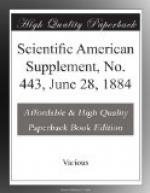All pigments of paint group according to their affinity to raw linseed oil into three classes. First, those that form chemical combinations, called soap. This kind is the most durable, is used for priming purposes, and consists of lead, zinc, and iron bases, of which red lead takes up the most oil; next, white lead, the pure carbonate Dutch process made, following with zinc white and iron carbonates, as iron ore paint, Turkey umber, yellow ocher; also faintly the chromates of lead—chrome-green and chrome-yellow, finishing with the poorest of all, modern white lead, made by the wet or vinegar process. The second class being neutrals have no chemical affinity to linseed oil; they need a large quantity of drier to harden the paint, and include all blacks, vermilion, Prussian, Paris, and Chinese blue, also terra di Sienna, Vandyke brown, Paris green, verdigris, ultramarine, genuine carmine, and madderlake. The last seven are, on account of their transparency, better adapted for varnish mixtures—glazing. The third class of pigments act destructively to linseed oil; they having an acid base (mostly tin salt, hydrochloride of tin, and redwood dye), form with the gelatinous matter of the oil a jelly that will neither work well under the brush nor harden sufficiently, and can be used in varnish for glazing only; they are not permanent in color, and among the most troublesome are the lower grades of so-called carmines, madderlakes, rose pinks, etc., which contain more or less acidous dyes, forming a soft paint with linseed oil that once dry on a job can be twisted or peeled off like the skin of a ripe peach. All these combinations of paint have to be closely observed by the painter to insure his success.




